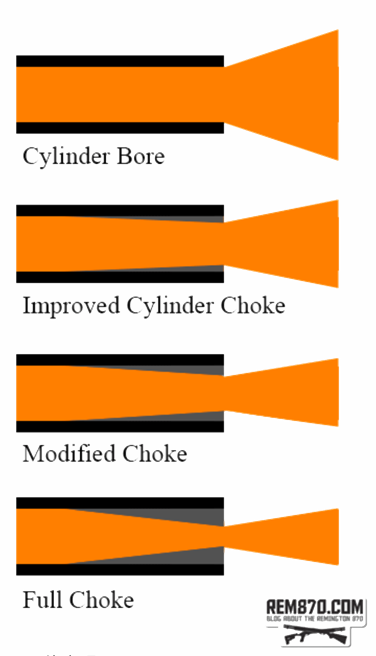Your Shotgun’s Choke is Important. Here’s Why.
Choke is probably the most misunderstood component of the shotgun … and one of the most important.
by HEIDI LYN RAO posted on September 2, 2021
The shotgun’s choke is probably the most misunderstood component of the shotgun itself; I spend a lot of classroom time explaining the different types of chokes and their intended purposes. That’s because by understanding a shotgun’s choke, you can dramatically improve your marksmanship. This translates to more broken clays, more game in the bag, and the best part, more confidence.
The Basics
First of all, what is a choke? A choke is a threaded device that is screwed into the end of the barrel that controls your shot pattern diameters through degree of constriction. Basically, the more constriction, the further the shot will travel before it “opens up.†Older shotguns have a choked barrel, in which the entire barrel is of a certain choke constriction. Modern shotguns have threading on the inside of the barrel at their muzzle-end to accept removable and interchangeable chokes.
Chokes come in several different options. A “flush†choke is screwed into the shotgun’s muzzle and is the same height, or flush, with the end of the barrel. “Extended†chokes, when screwed into the shotgun’s muzzle, stick out, or extend, slightly past the muzzle. There are further options of extended chokes as well, like “ported,†which allows some of the gases to escape before the shot exits the barrel, which also reduces recoil a bit.
How Can You Tell?
Each manufacturer has its own way of marking chokes. Some chokes are identified by notches on the outer edge of the device, which can be viewed from the end of the barrel. Others have asterisks marked on the side of the choke, which can only be viewed when the choke is removed. Some of the extended chokes either have color-coded markings on the end of the choke or are labeled with the type of constriction to easily identify.

Always check with the manufacturer or ask a reputable shotgun dealer to make certain you know what type of choke you are working with. Always make sure you have the right choke that is designed to fit into your make and model of shotgun. As a rule of thumb, chokes are not interchangeable across shotguns. Just because you have a choke for your 12-gauge Browning does not mean you can put that same choke into your 12-gauge Remington. (choke-type graphic courtesy Rem870.com)
Cylinder (Open) Choke
A cylinder choke has no constriction. The absence of constriction means that your shot pattern “opens up†very quickly. With no constriction, a cylinder choke distributes approximately 40 percent of a shotshell’s total pellets in a 30″ circle at 40 yards. Note: if you want to shoot an “open†choke, you must insert a cylinder choke in your shotgun if your shotgun is threaded for a choke. Never shoot your shotgun without a choke inserted if your shotgun is threaded for a choke.
Skeet Choke
A skeet choke is a threaded choke that has slightly more constriction than a cylinder choke. As the name implies, this choke was designed to be used by skeet shooters when shooting close clay targets. A skeet choke distributes approximately 50 percent of a shotshell’s total pellets in a 30″ circle at 40 yards, and is ideal for targets ranging from 15 to 25 yards.
Improved Cylinder Choke
An improved cylinder choke is a threaded choke that has slightly more constriction than a skeet choke. This choke distributes approximately 50 percent of a shotshell’s total pellets in a 30″ circle at 40 yards, and is ideal for targets ranging from 20 to 30 yards.
Modified Choke
A modified choke is a threaded choke that has slightly more constriction than an improved cylinder choke. This choke delivers approximately 60 percent of a shotshell’s total pellets in a 30″ circle at 40 yards, and is a good all-around choke when you’re not sure of the distances you’ll need to shoot.
Full Choke
A full choke is a threaded choke that has slightly more constriction than a modified choke. This choke has tight constriction and a dense pattern, delivering approximately 70 percent of a shotshell’s total pellets in a 30″ circle at 40 yards, and is used for shots longer than 40 yards.
Shotgun Chokes by Use
Hunting
Chokes in hunting have a specific purpose: a quick, clean and ethical kill. You need to match up the choke to the game you are pursuing. Many hunters will have a set of three chokes: improved cylinder, modified and full. For example, if you are hunting quail and the birds are flushing at 15 to 20 yards, you would probably opt for an improved cylinder choke. But if you are hunting geese and they are coming in low early morning, you may start out with a modified choke. As the day warms up and the geese come in higher, you can change to a full choke.
Personal Protection
Today’s personal-defense shotguns are different from the personal-defense shotguns of just a few years ago. Personal protection, or “riot†shotguns, had barrels that were almost exclusively unthreaded and open-choked. Today’s personal-defense shotgun may or may not be threaded for a choke. If your shotgun is threaded, you must decide which choke you want and how far you want your pattern to extend. The same safety precautions apply to chokes in shotguns for personal defense as for all other shotgun chokes.
Shotgun Games
There are as many different shotgun games as there are different types of shotgunners. Some of the most common games are skeet, trap, sporting clays and 5-stand. Each of these games might call for a different choke, and many shooters carry additional chokes in their pouch and change throughout the shotgun course, depending on the known distance of the next target.
Editor’s Note: This isn’t all there is to know about shotgun chokes! Check out 5 Critical Facts about Shotgun Chokes & Safety for some important information you may not have known.
